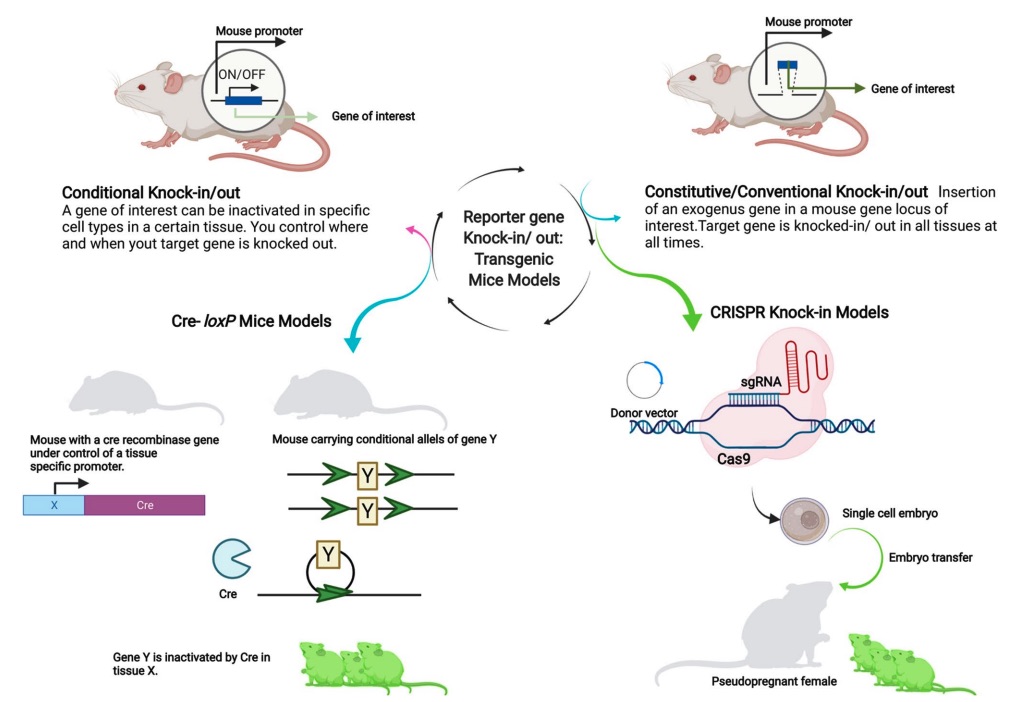Knockin Models
Knock-in mouse models are mice generated by the genetic manipulation of embryonic stem (ES) cells such that a specific genetic locus has been altered either by the one-for-one substitution of DNA sequence information or by the addition of sequence information not found in the endogenous genetic locus. Creative Biolabs provides various knock-in models using both ESC/HR-based and nuclease-based targeting strategies. These models can be broadly divided into conventional models, conditional models, and humanized models.
More specifically, specific mutations (e.g., point mutations), a reporter gene (e.g., EGFP, RFP, LacZ), or a functional cDNA (e.g., Cre, Dre) can be introduced into the target place. Controlled by the endogenous promoter, these foreign DNA sequences show an expression consistent with the target gene. Another situation is to replace the target gene with a cDNA or a reporter gene, where knock-out takes place together with knock-in. Humanized mouse models can also be generated with the replacement of a mouse gene with its human counterpart. Please click the links below for more information:
 Fig. 1 State-of-the-art technologies and approaches for the development of transgenic mouse models.1
Fig. 1 State-of-the-art technologies and approaches for the development of transgenic mouse models.1
Humanized mouse models can be created by exchanging murine genes with their human orthologs, where a portion of or the full mouse gene sequence is replaced by its human counterpart and the human gene is expressed under the control of the mouse regulatory sequences.
By introducing point mutation(s) into homology arms or the targeting vector, the desired mutation(s) can be incorporated into the target gene and is (are) permanently expressed at all times under the control of wildtype gene regulatory elements.
Conditional Point Mutation
A conditional point mutant is generated in a time-controlled or tissue-specific manner, thus bypassing the deleterious effects of your mutation on embryonic development. Which means they don't express the mutant sequence until you choose to activate it. For tissue-specific point mutation models, expression of the mutant gene takes place only in tissues where Cre is active. For inducible point mutants, the inserted sequence is only expressed when the inducers are present.
The coding sequence of the target gene can be replaced with a visually detectable marker gene (e.g., GFP and lacZ) for the purpose of monitoring the activity of the endogenous promoter. Alternatively, a reporter gene can be knocked into the end (or the beginning) of the coding sequence to form a fusion protein so as to monitor the expression of that gene at the transcriptional or translational level and examine protein localization/trafficking.
ROSA26 is known to be an ideal locus to integrate a transgene to have stable and ubiquitous expression. Creative Biolabs provides knock-in mice and rat models which the transgene is safely inserted into ROSA26 locus. Herein, the expression of the inserted gene can be driven by the endogenous ROSA26 promoter or by a promoter of choice that is targeted into the locus along with the gene.
Besides ES cell/HR- based gene targeting method, Creative Biolabs is capable of using CRISPR/Cas9 technique to create knock-in mice models quickly and stably. With the latest technologies, both point mutations and large fragment insertions can be achieved.
Knock-in mouse models are frequently generated for use of gene function study, pathogenic mechanisms exploration and drug development. At Creative Biolabs, a comprehensive list of knock-in models can be obtained based on the homologous recombination technologies as well as nuclease-mediated gene targeting methods. Design the model for yourself and we'll do the ‘proof of concept' work, or consult Creative Biolabs' highly experienced technical team for an optimal model creation strategy to boost your next project and beyond.
Additionally, related services of genetically engineered mouse models which you may be interested in are listed below for you to review:
If you are interested in any of these services, please contact us or send us an inquiry for more information or a formal quote.
Reference
- Chawda, Chintan, et al. "Monitoring immune cell function through optical imaging: a review highlighting transgenic mouse models." Molecular Imaging and Biology 24.2 (2022): 250-263. Doi:10.1007/s11307-021-01662-5. Distributed under Open Access license CC BY 4.0, without modification.
For Research Use Only.
